The Parish Church of Saint Bartholomew
It is thought that the first church on this site was erected around 1140.
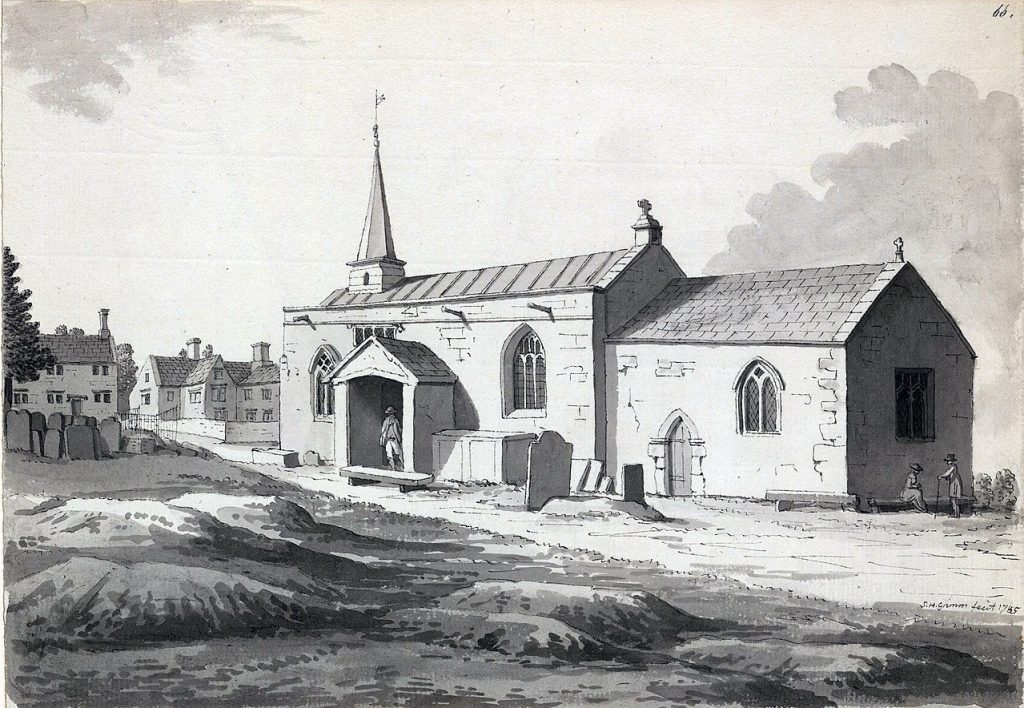
It was demolished in 1863 in favour of a new church on the present site.
This is the Church which opened in 1863 but sadly destroyed by fire in January 1895.
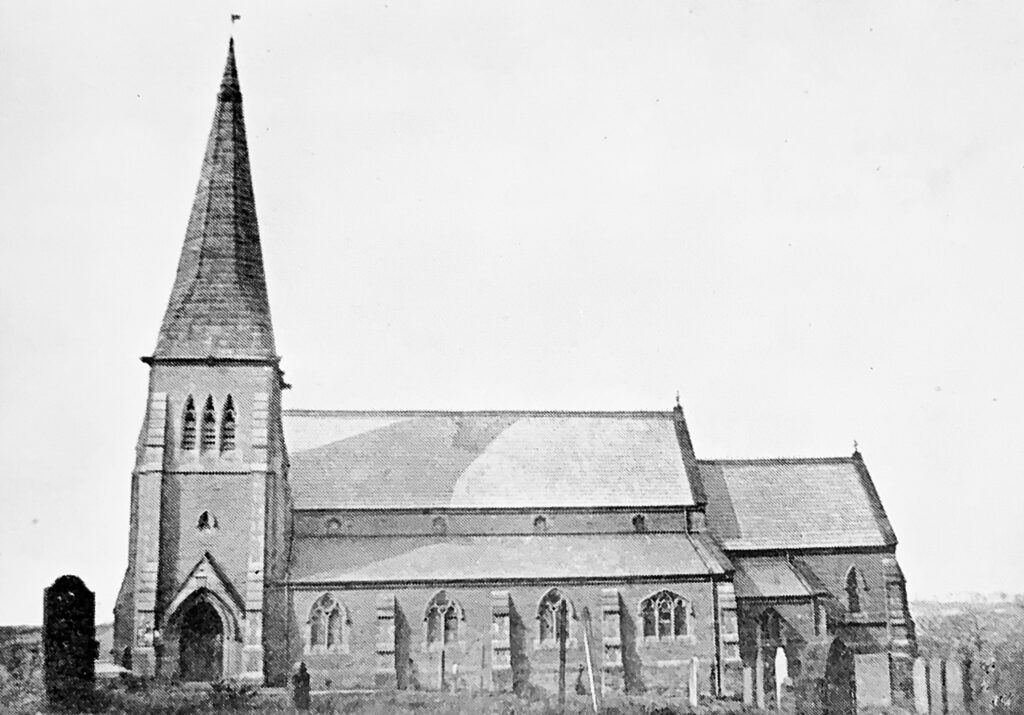
Two scotch pines were planted to the south west to mark the place of the old Norman church, which are still visible at the front of the present church.
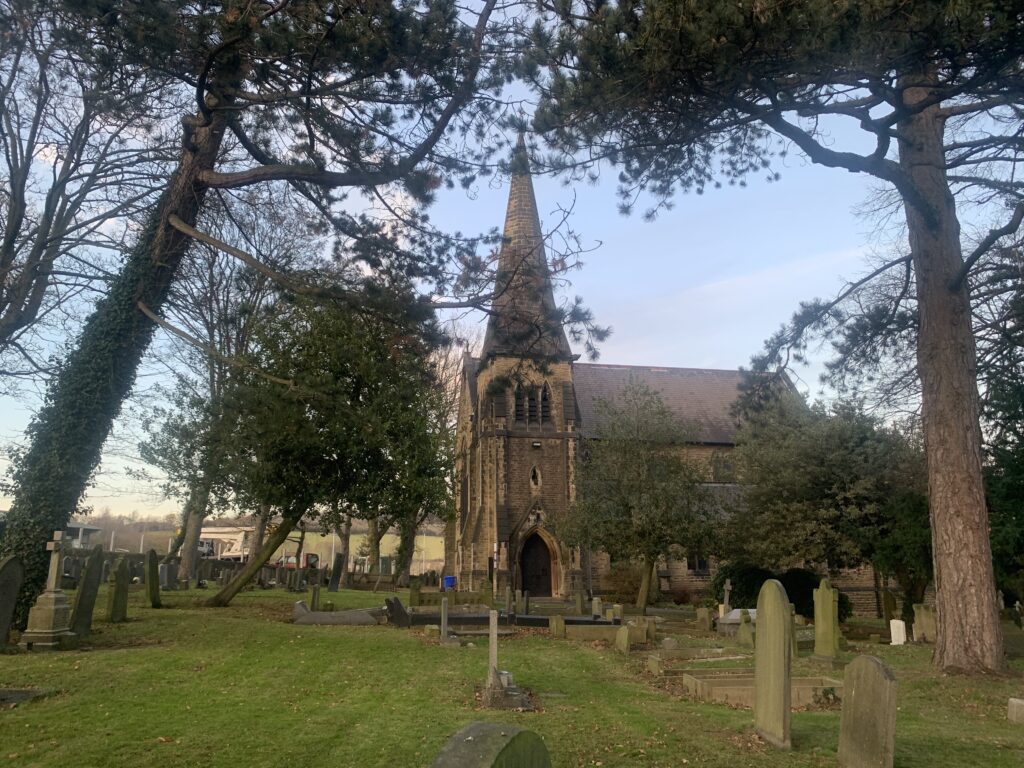
This second church was destroyed by fire on 29th January 1895 and was restored by public subscription and reopened on 25th September 1896. (There is an interesting account from C W Lee’s diary outlining the fire and the subsequent opening of the new church on the Mosborough History Website)
Entrance is via the door on the south side of the church. The porch where you enter, with the tower and spire above it, are the oldest part of the church, dating from 1863 when the old Norman church was demolished and the porch, tower and spire are the only parts of the 1863 church to survive the disastrous fire of 1895.
Entrance to the Church was, as now, through the main door in the South wall of the tower. Of similar proportions to the present Church it had accommodation for 600.
The Derbyshire Times of that week concluded its report of the fire:
"Of all that noble and sacred pile, nothing remains but the tower and the bells.These have been saved and will be the only connecting link between the old Parish Church and the new one that will have to be raised in itsplace.“
On the right is the services/toilets area.
On your left is the stairs to the ringing chamber.
In the 1760’s the church had two bells hung in a square tower and a sanctus bell hung above the chancel. In 1785 the two bells were re-cast and these bells were regularly rung on May 29th and Nov 5th as a reminder of the restoration of the monarchy. When the church was rebuilt in 1863 the two bells were moved to the new church tower. In 1880 two more bells were added cast by William Blews, bringing the peel to four. At the height of the fire in 1895, although the tower was alight, the fire brigade managed to save the tower and bells from destruction. In 1925 the four bells were re-cast by John Taylor of Loughborough and a fifth added. In 1947 a sixth bell was added inscribed ‘Victory Bell’1939-1945.
The first peal of the six bells was rung on January 19th 1948.
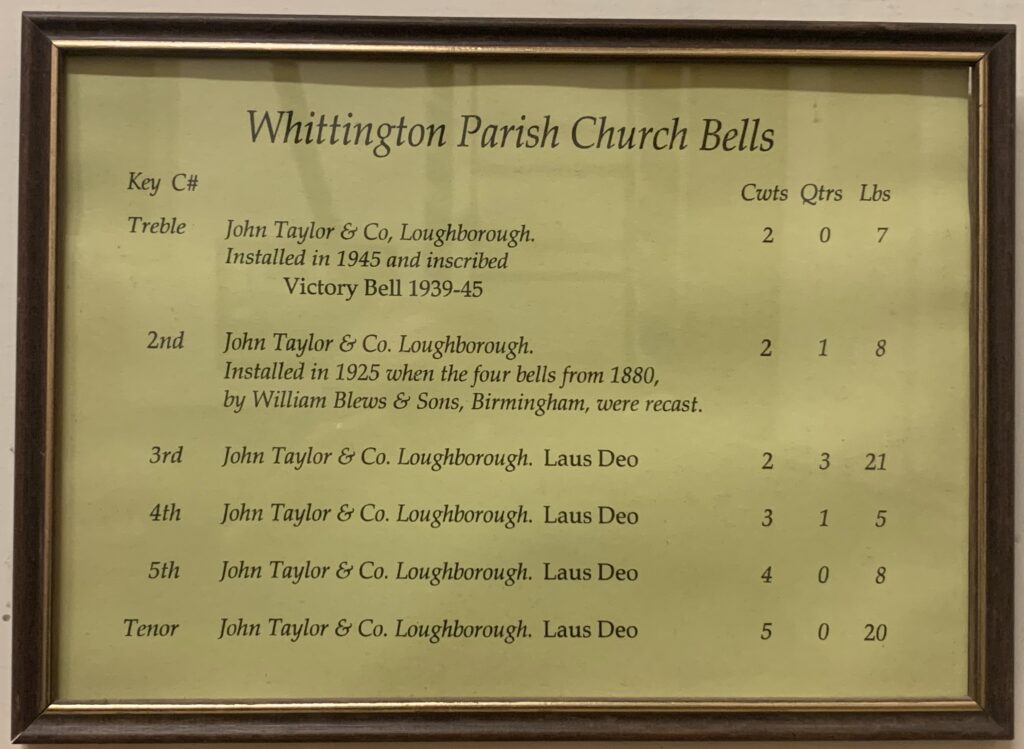
On the walls of the ringing chamber are plaques commemorating peals rung for King George V and Queen Mary’s Silver Jubilee the first ever peal on the full six bells, and a peal rung after the death of a long serving ringer. A plaque also commemorates the installation of a sixth bell in 1947.
The spire is one hundred feet high and one of the landmarks of the Derbyshire countryside.
On the window ledge of the tower is a model of the church as it looked in 1863.
Moving forward through the double doors immediately on your your left there is a board recording the rectors of Whittington from as far back as the year 1219.
You will now enter the social area of the church created in 1994 with funds from the sale of the old Church Hall on Church Street which had been beyond viable repair. This area includes a kitchen and meeting area used by church groups and provides the venue for social events.
On the right hand side is a memorial to all those who died in the First World War a smaller board on the left records those who died in the Second World War. Additional information is available in the folders which are available for viewing.
On the left after the kitchen area is the old Baptistry which was changed as part of the refurbishment in 1993/4.
A small brass on the Chancel arch records that this Church destroyed by fire January 29th 1895, restored by public subscription. Was re-opened September 1896.
Looking now through the doors you can see the layout of the main body of the church.
It consists of a nave, north and south aisles, choir and sanctuary, organ chamber, vestry and baptistry. The nave has a close-boarded trussed rafter roof and is a replica of an upturned boat
As part of the refurbishment, mentioned above, the position of the choir stalls was changed the main Altar brought forward and font moved from the Baptistry to the front of the church.
Now moving down the North aisle the first stained glass window (by Morris & Co of Merton Abbey) depicts Hugh Latimer (c. 1487 – 16 October 1555) was a Fellow of Clare College, Cambridge, and Bishop of Worcester before the Reformation, and later Church of England chaplain to King Edward VI. In 1555 under the Catholic Queen Mary he was burned at the stake, becoming one of the three Oxford Martyrs of Anglicanism. He fell foul of the Church authorities when he began to preach publicly on the need for the translation of the Bible into English. This was a dangerous move as the first translation of the New Testament by William Tyndale had recently been banned. In early 1528, Latimer was called before Cardinal Thomas Wolsey and he was given an admonition and a warning. when Edward VI’s sister Mary I came to the throne, he was tried for his beliefs and teachings in Oxford and imprisoned. In October 1555 he was burned at the stake outside Balliol College, Oxford
and Thomas Cranmer (2 July 1489 – 21 March 1556) was a leader of the English Reformation and Archbishop of Canterbury during the reigns of Henry VIII, Edward VI and, for a short time, Mary I. He helped build the case for the annulment of Henry’s marriage to Catherine of Aragon, which was one of the causes of the separation of the English Church from union with the Holy See. During Cranmer’s tenure as Archbishop of Canterbury, he was responsible for establishing the first doctrinal and liturgical structures of the reformed Church of England. He wrote and compiled the first two editions of the Book of Common Prayer, a complete liturgy for the English Church. After the accession of the Catholic Mary I, Cranmer was put on trial for treason and heresy. Imprisoned for over two years and under pressure from Church authorities, he made several recantations and apparently reconciled himself with the Catholic Church. While this would have normally absolved him, Mary wanted him executed, and, on the day of his execution, he withdrew his recantations, to die a heretic to Catholics and a martyr for the principles of the English Reformation
The window is dedicated to the memory of CATHERINE and MARY HIBBERD.
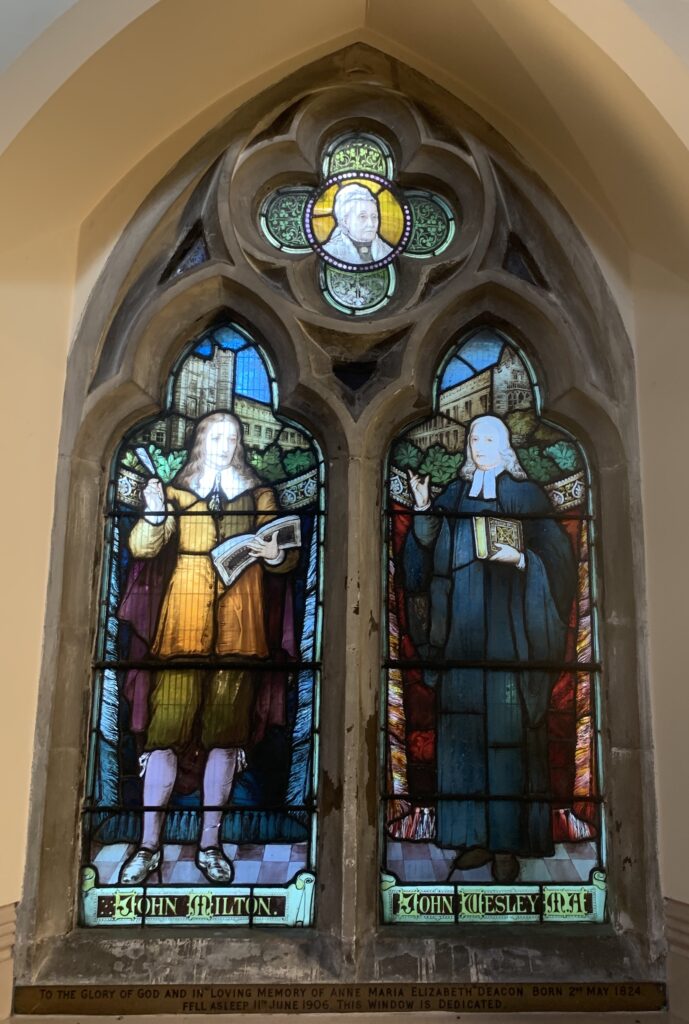
The second window depicts John Milton (9 December 1608 – 8 November 1674) was an English poet and intellectual who served as a civil servant for the Commonwealth of England under its Council of State and later under Oliver Cromwell. He wrote at a time of religious flux and political upheaval, and is best known for his epic poem Paradise Lost (1667), written in blank verse, and widely considered to be one of the greatest works of literature ever written. Writing in English, Latin, Greek, and Italian, he achieved international renown within his lifetime; his celebrated Areopagitica (1644), written in condemnation of pre-publication censorship, is among history’s most influential and impassioned defences of freedom of speech and freedom of the press
and John Wesley (28 June 1703 – 2 March 1791) was an English cleric, theologian and evangelist who was a leader of a revival movement within the Church of England known as Methodism. 1726 and ordained as an Anglican priest two years later. He led the “Holy Club”, a society formed for the purpose of the study and the pursuit of a devout Christian life; it had been founded by his brother, Charles. On 24 May 1738, he experienced what has come to be called his evangelical conversion, when he felt his “heart strangely warmed” A key step in the development of Wesley’s ministry was, to travel and preach outdoors. Moving across Great Britain and Ireland, he helped form and organize small Christian groups that developed intensive and personal accountability, discipleship and religious instruction. He appointed itinerant, unordained evangelists to care for these groups of people. The societies he founded became the dominant form of the independent Methodist movement that continues to this day. Under Wesley’s direction, Methodists became leaders in many social issues of the day, including prison reform and the abolition of slavery.
The window is dedicated to the memory of ANNE MARIA ELIZABETH DEACON. The mother of Maurice Deacon, industrialist, mine owner and one time owner of Sheepbridge Engineering Works. The small centre light depicts a true likeness of Mrs DEACON taken from a contemporary photograph.
On the north wall is a framed sketch of a fragment of medieval stained glass from the old Norman church.
Also to be found here is the finely worked MOTHERS’ UNION banner in its mahogany case (the case having been made in 1969).
The window next to the Lady Chapel depicts The Earl of Shaftsbury Anthony Ashley Cooper, 7th earl of Shaftesbury, in full Anthony Ashley Cooper, 7th earl of Shaftesbury, Baron Cooper of Pawlett, Baron Ashley of Wimborne St. Giles, (born April 28, 1801, London, England—died October 1, 1885, Folkestone, Kent) It is said he was one of the most effective social and industrial reformers in 19th-century England. He was also the acknowledged leader of the evangelical movement within the Church of England. He was influential in legislation to restrict the working hours in factories to 10, to bring an end to the use of youngs boys climbing chimneys as sweeps and ending the use of children under the age of 10 working underground in mines. He insisted the Government sponsor low cost housing for urban workers and was also president of the Ragged Schools Union for 39 years
Together with W.E. Gladstone (29 December 1809 – 19 May 1898) was a British statesman and Liberal politician. In a career lasting over 60 years, he served for 12 years as Prime Minister of the United Kingdom, spread over four terms beginning in 1868 and ending in 1894. (He was PM at the time of the opening of this current church) He also served as Chancellor of the Exchequer four times, serving over 12 years.
and Bishop Ridding of Southwell (16 March 1828 – 30 August 1904) was an English headmaster and bishop. He was Headmaster of Winchester College and became Bishop of Southwell in 1884.
At the time of the present church being commissioned Derbyshire was in the Diocese of Southwell.
The window is dedicated to the memory of ADELAIDE DEACON. (The first wife of Maurice Deacon)
At the east end of the north aisle is the LADY CHAPEL furnished by parishioners in 1963 to mark a century of worship on the site. The woodwork was produced by Samuel Rodgers formerly of Whittington. The Chapel was designed by Mr R Grainger, Parochial Reader.
You will now pass the the pulpit which is the work of Ashover craftsman, George Eastwood and was gifted by Mr Holford and the Misses Holford.
You can now enter the chancel. Straight in front of you is the main Altar and Choir Stalls which were the gift of Rev. John Tomlinson, who was the Rector of the Church at the time of the fire and responsible for the re-building. The carving of the Choir Stalls was also the work of George Eastwood from Ashover.
The Reredos behind the altar represent the work of the former Whittington firm of Samuel Rodgers.
Behind the Altar is an area known as an ‘encaustic pavement’ that is an area made up of tiles made not by glazing but by blending different colours of clay. These were made by Maw & Co one of the main makers of these types of tiles. They also experimented making encaustic tiles and incorporating lettering which needed to cross joints making the design very difficult. One of the known tiles is listed as being at St Bartholomew’s, however we have 2 one either side of the Altar.
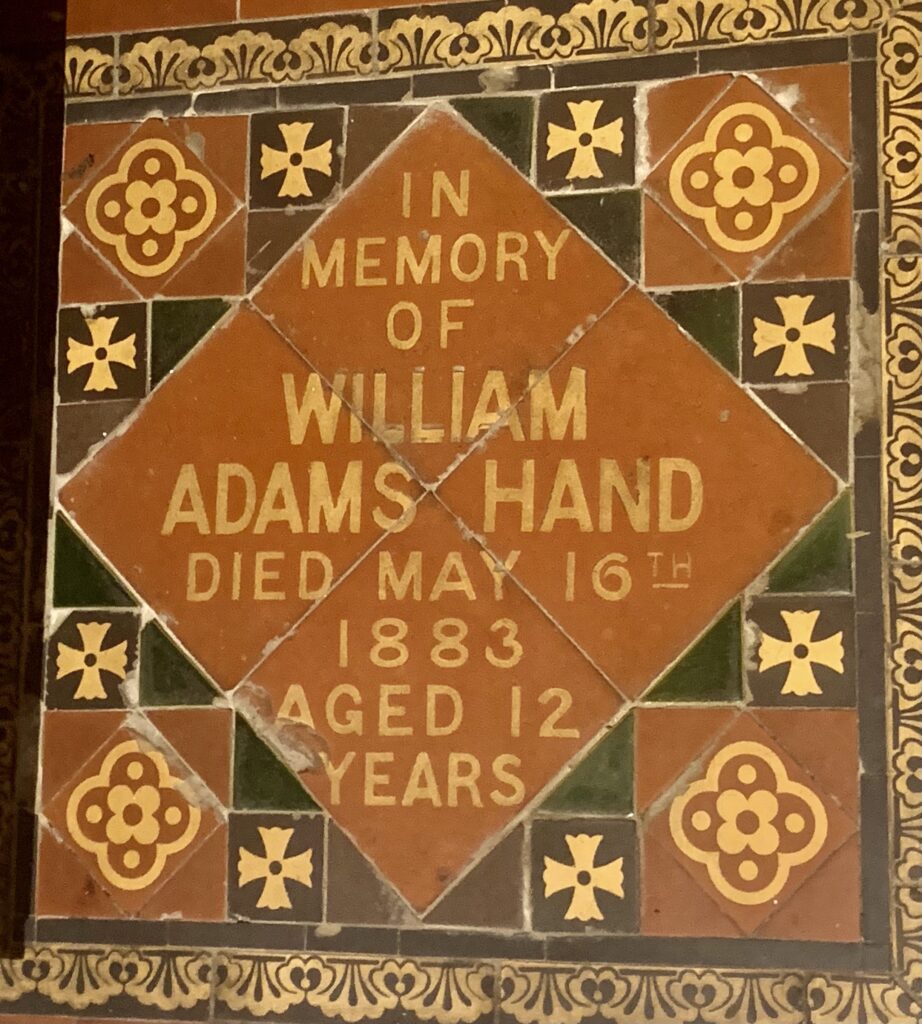
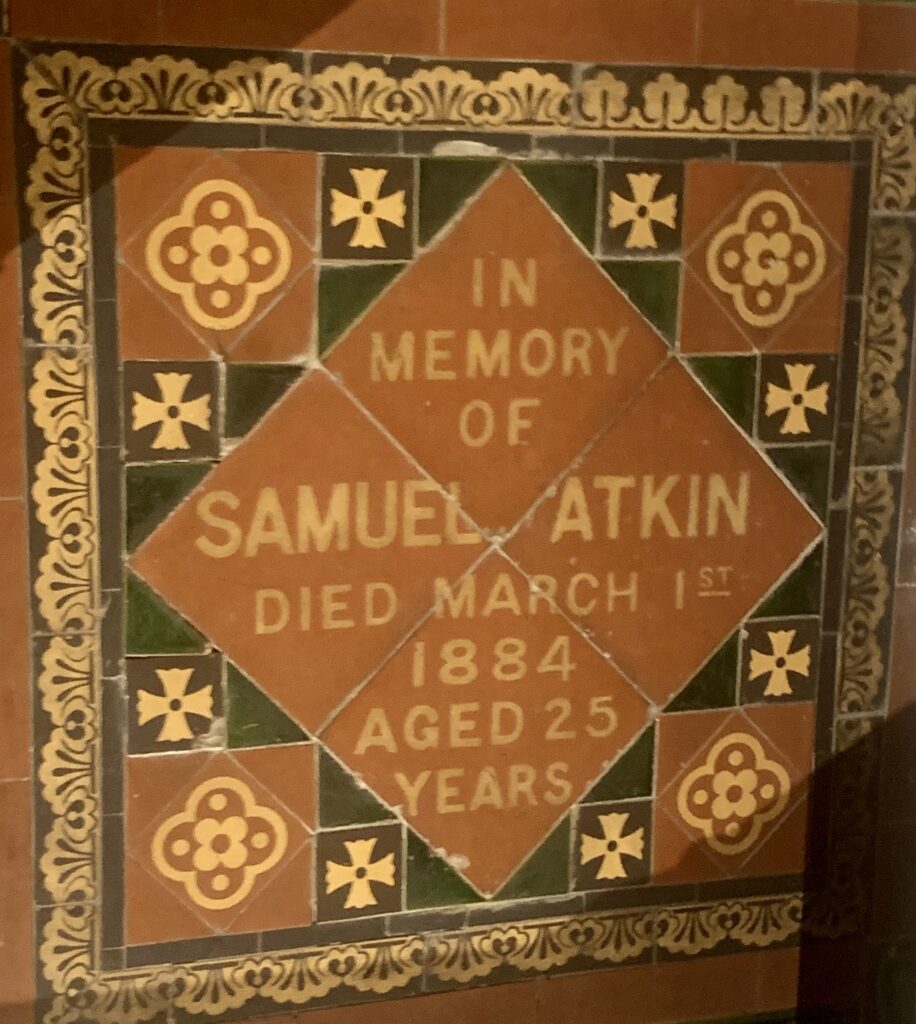
The Sanctuary rails, the Eagle Lectern (which you will see as you leave the chancel) and the Organ Screen were executed by Bernard Dorrington of Heanor, and bear memorial inscriptions.
The organ, two manuals and pedal, was built by Messrs. Holdich and Ingram of London and installed in 1896 at a cost of £280! It is thought that this was probably the last organ built by this partnership as George Holdich died that year. (George Holdich built an organ which was exhibited at the Great Exhibition in 1851 and was responsible for building the organ in Lichfield Cathedral in 1861 which had 52 stops). The opening recital was given by the Rev. T. H. Spinney. Vicar of Newborough, whose anthems were for many years in the repertory of the Church Choir. The organ was re-built in 1938 and again in 1994, this final time by Chalmers and Hyde.
You can also see a Glastonbury chair was given by Mr John Smith of Brimington and a very beautifully carved Litany desk which was presented to the Church by J. W. E. and Miss Lottie Clayton.
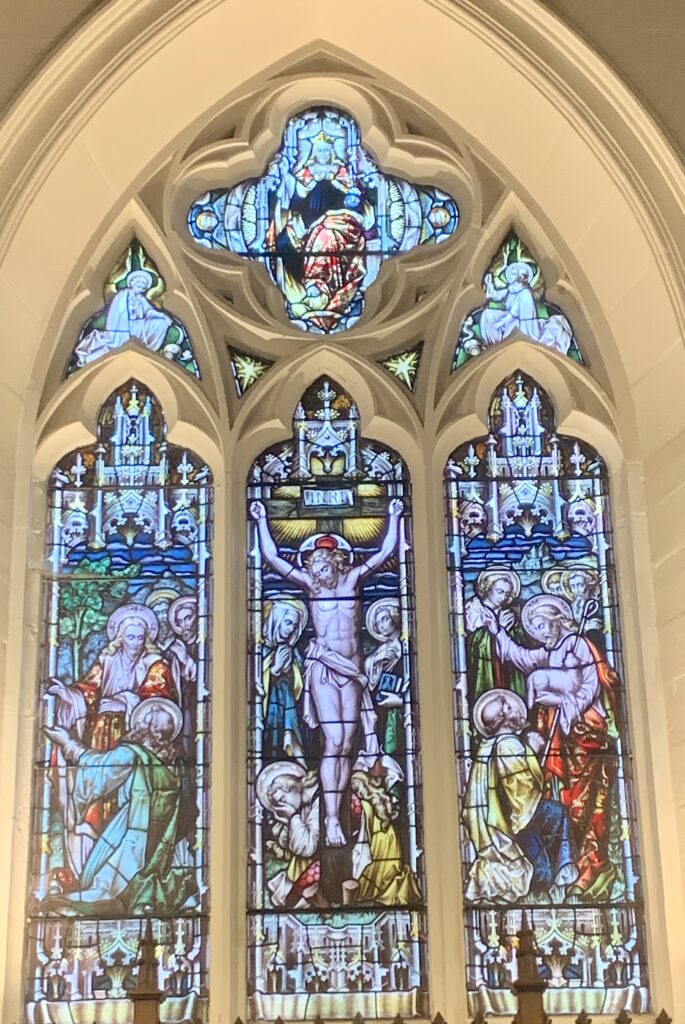
You can look up at the impressive East window which has the Crucifixion scene in the centre light. With representative scenes from the life of St. Bartholomew the patron Saint on either side. St. Bartholomew was one of the twelve apostles of Jesus according to the New Testament. The Church of England and other Anglican churches also honour him on August 24. It is believed he preached in India and Greater Armenia, and converted King Polymius to Christianity. He was subsequently flayed (skinned) alive and crucified head down (some accounts suggest he was beheaded) by Polymius’ brother Prince Astyages in revenge and in fear of a Roman backlash. Tradition has the place as Abanopolis on the west coast of the Caspian Sea and that he also preached in Mesopotamia, Persia, and Egypt.
The window was made possible by public subscription.
From the Chancel steps you can turn and take the advantage of viewing the West window a memorial to parishioners who fell in the First World War, this window was designed by Messrs. Jones and Willis of Birmingham and depicts four soldier saints,
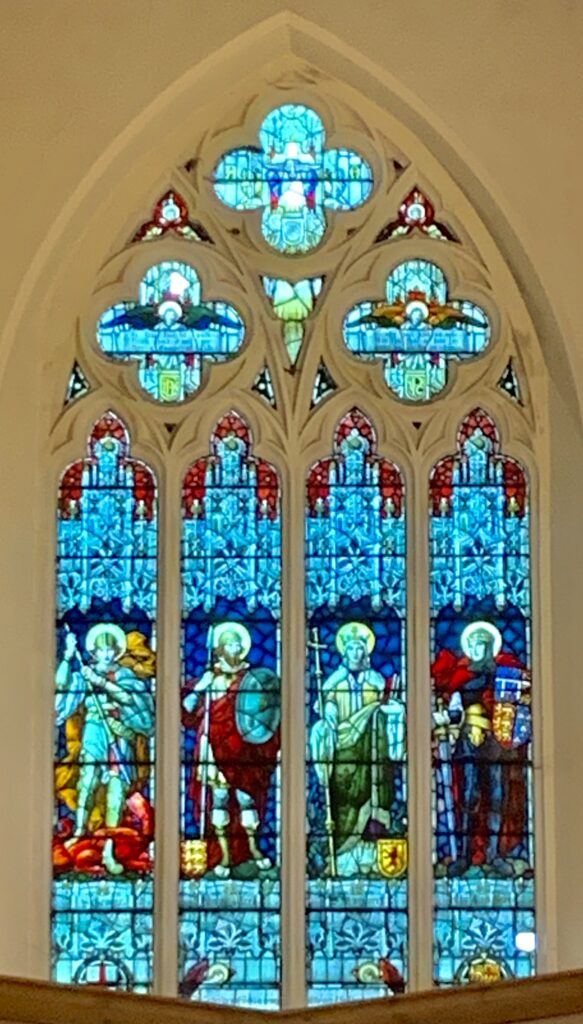
St. George (d. 23 April 303),was a Christian who is accepted as a saint in Christianity and Islam. According to traditional rumours, he was a soldier in the Roman army The legend of Saint George and the Dragon was first recorded in the 11th century, in a Georgian source. It reached Catholic Europe in the 12th century. The tradition tells that a fierce dragon was causing panic at the city of Silene, Libya, at the time George arrived there. In order to prevent the dragon from devastating people from the city, they gave two sheep each day to the dragon, but when the sheep were not enough they were forced to sacrifice humans instead of the two sheep. The human to be sacrificed was elected by the city’s own people and one time the king’s daughter was chosen to be sacrificed but no one was willing to take her place. George saved the girl by slaying the dragon with a lance. The king was so grateful that he offered him treasures as a reward for saving his daughter’s life, but George refused it and instead he gave these to the poor. The people of the city were so amazed at what they had witnessed that they became Christians and were all baptized. George was executed by decapitation before Nicomedia’s city wall, on 23 April 303 as a result of the Diocletianic or Great Persecution which was the last and most severe persecution of Christians in the Roman Empire.
King Alfred. (Also known as Alfred the Great),(848/9 – 26 October 899) was king of Wessex from 871 to c. 886 and king of the Anglo-Saxons from c. 886 to 899. He was the youngest son of King Æthelwulf of Wessex. His father died when he was young, and three of Alfred’s brothers reigned in turn before him. After ascending the throne, Alfred spent several years fighting Viking invasions. He won a decisive victory in the Battle of Edington in 878 and made an agreement with the Vikings, creating what was known as the Danelaw in the North of England. Alfred also oversaw the conversion of Viking leader Guthrum to Christianity. He defended his kingdom against the Viking attempt at conquest, becoming the dominant ruler in England. Alfred had a reputation as a learned and merciful man of a gracious and level-headed nature who encouraged education, proposing that primary education be conducted in Old English rather than Latin and improving the legal system and military structure and his people’s quality of life. He was given the epithet “the Great” during and after the Reformation in the 16th century
The cake legend
A legend tells how when Alfred first fled to the Somerset Levels, he was given shelter by a peasant woman who, unaware of his identity, left him to watch some wheaten cakes she had left cooking on the fire.Preoccupied with the problems of his kingdom, Alfred accidentally let the cakes burn and was roundly scolded by the woman upon her return. There is no contemporary evidence for the legend, but it is possible that there was an early oral tradition. The first time that it was actually written was about 100 years after Alfred’s death.
Queen Margaret of Scotland (also known as Saint Margaret of Scotland)c. 1045 – 16 November 1093), also known as Margaret of Wessex, was an English princess and a Scottish queen. Margaret was sometimes called “The Pearl of Scotland”. Born in exile in the Kingdom of Hungary, Margaret and her family returned to the Kingdom of England in 1057, but fled to the Kingdom of Scotland following the Norman conquest of England in 1066. By the end of 1070, Margaret had married King Malcolm III of Scotland, becoming Queen of Scots. She was a very pious Roman Catholic,
Under Queen Margaret’s leadership Church councils promoted Easter communion and, much to joy of the working-class, abstinence from servile work on a Sunday. Margaret founded churches, monasteries and pilgrimage hostels and established the Royal Mausoleum at Dunfermline Abbey with monks from Canterbury. She was especially fond of Scottish saints and instigated the Queen’s Ferry over the Forth so that pilgrims could more easily reach the Shrine of St. Andrew.
Mass was changed from the many dialects of Gaelic spoken throughout Scotland to the unifying Latin. By adopting Latin to celebrate the Mass she believed that all Scots could worship together in unity, along with the other Christians of Western Europe. Many people believe that in doing this, it was not only Queen Margaret’s goal to unite the Scots, but also the two nations of Scotland and England in an attempt to end the bloody warfare between the two countries
and The Black Prince. Edward, prince of Wales (1330-1376), known from Tudor times as the Black Prince, was the oldest son of Edward lll and of Philippa of Hainault.
He is remembered as a great war captain. At Crécy in 1346, when he was only sixteen, he fought very gallantly alongside his father. At Poitiers in 1356, he won his greatest victory, capturing the French king, Jean II, and his rich baggage.
This window was also funded through public subscription.
Moving now towards the South aisle, passing the font which was made by Robert Bridgeman of Lichfield (some of his major commissions includes the Gothic façade of the John Rylands Library, Deansgate, Manchester and restoration work on the west front of Lichfield Cathedral during the 1880s).
In the south aisle adjacent to the font the window depicts the early life of the church ARCHBISHOPS Aborius (or Eborius) who was the first bishop of Eboracum (later York) known by name. Eborius is only mentioned as one of the three bishops from Roman Britain attending the Council of Arles in 314 This first council of Arles took place a year after the Edict of Milan, in which Christianity became a legal religion. The council was convoked by Constantine the Great.
Another of the Archbishops attending was Restitutus was a Romano-British bishop, probably from Londinium (London). One of the decisions reached was that Easter should be held on the same day throughout the world, rather than being set by each local church. (The other Archbishop, not shown, attending is thought to be Adelfius, from Lincoln).
Pictured between them is St.Alban is venerated as the first-recorded British Christian martyr, for which reason he is considered to be the British protomartyr. Alban is remembered for a meeting a Christian priest fleeing from persecutors and sheltered him in his house for a number of days. The priest, who later came to be called Amphibalus, meaning “cloak” in Latin, prayed and “kept watch” day and night, and Alban was so impressed with the priest’s faith and piety that he found himself emulating him and soon converted to Christianity. The local prince was not happy and ordered Roman soldiers to make a strict search of Alban’s house. As they came to seize the priest, Alban put on the priest’s cloak and clothing and presented himself to the soldiers in place of his guest. Alban was brought before a judge, when the judge heard that Alban had offered himself up in place of the priest, he became enraged that Alban would shelter a person who “despised and blasphemed the gods,” and later gave orders for Alban to be beheaded.
The window is dedicated to the memory of ALFRED WILSON DAVIES a long-time curate of the church who died in 1903.
The window was funded by the Rector, Wardens and Parishioners.
The second window depicts Bishop Kentigern known as Mungo, was a missionary in the Scottish Kingdom of Strathclyde in the late sixth century, and the founder and patron saint of the city of Glasgow. Having been ordained priest, Kentigern set out to restore the faith at Glasgow. He crossed the Forth at Alloa and set up his church on the Molendinar Burn, where Glasgow Cathedral now stands at the top of the High Street. Due to a Pagan uprising Kentigern travelled to Wales where he founded a monastery in the Vale of Ciwyd. He was able to return to Scotland in 573. He stopped at Hoddam, by Dumfries, and established missions throughout Galloway, which had been converted 150 years earlier by St Ninian. After eight years Kentigern returned to Glasgow, It was nearby, in Kilmacolm, that he was visited by Saint Columba, who was at that time labouring in Strathtay. The two saints embraced, held long converse, and exchanged their pastoral staves. He died in January 603.
and Archbishop David c. 510 – c. 601) was a Welsh bishop of Mynyw (now St Davids) during the 6th century. He is the patron saint of Wales. He became renowned as a teacher and preacher, founding monastic settlements and churches in Wales, Dumnonia, and Brittany. St David’s Cathedral stands on the site of the monastery he founded in the Glyn Rhosyn valley of Pembrokeshire. The Monastic Rule of David prescribed that monks had to pull the plough themselves without draught animals, must drink only water and eat only bread with salt and herbs, and spend the evenings in prayer, reading and writing. No personal possessions were allowed: even to say “my book” was considered an offence. He lived a simple life and practised asceticism, teaching his followers to refrain from eating meat and drinking beer. His symbol, also the symbol of Wales, is the leek.
and is dedicated to the memory of DOROTHY DEACON (the daughter of Maurice Deacon) donated by the Staffs of Sheepbridge Engineering Works and Collieries.
The third window depicts Archbishop Paulinus (died 10 October 644) he was a Roman missionary and the first Bishop of York.A member of the Gregorian mission sent in 601 by Pope Gregory 1 Christianize the Anglo-Saxons from their native Anglo-Saxon paganism, Paulinus arrived in England by 604 with the second missionary group. After some years spent in Kent, perhaps in 625, Paulinus was consecrated a bishop. He accompanied the sister of King Eadbald of Kent, on her journey to Northumbria to marry King Edwin of Northumbria, and eventually succeeded in converting Edwin to Christianity. Paulinus also converted many of Edwin’s subjects and built some churches. One of the women Paulinus baptised was a future saint, Hilda of Whitby. Paulinus returned to Kent, where he became Bishop of Rochester. He received a pallium from the pope, symbolizing his appointment as Archbishop of York, but too late to be effective. After his death in 644, Paulinus was canonized as a saint
and Archbishop Augustin (born first third of the 6th century – died probably 26 May 604) he was a Benedictine monk who became the first Archbishop of Canterbury in the year 597. He is considered the “Apostle to the English” and a founder of the English Church Augustine was the prior of a monastery in Rome when Pope Gregory the Great chose him in 595 to lead a mission, usually known as the Gregorian mission, to Britain to Christianize King Aethelberht and his Kingdom of Kent from Anglo-Saxon paganism. Before reaching Kent, the missionaries had considered turning back, but Gregory urged them on, and in 597, Augustine landed on the Isle of Thanet and proceeded to Aethelberht’s main town of Canterbury. Augustine was consecrated as a bishop and converted many of the king’s subjects, including thousands during a mass baptism on Christmas Day in 597. Pope Gregory sent more missionaries in 601, along with encouraging letters and gifts for the churches, although attempts to persuade the native British bishops to submit to Augustine’s authority failed. Roman bishops were established at London, and Rochester in 604, and a school was founded to train Anglo-Saxon priests and missionaries. Augustine also arranged the consecration of his successor, Laurence of Canterbury. The archbishop probably died in 604 and was soon revered as a saint.
and is also to the memory of DOROTHY DEACON who died in 1903. Funding was from ‘Friends of Her Sorrowing Parents’.
On the west wall is a memorial tablet for the former daughter chapel SS. Simon and Jude, Sheepbridge. Originally in 1875 a temporary iron building was replaced in 1958. Unfortunately however was closed in 1987.
You should now re enter the meeting area. Looking to the right the window in what was the Baptistry depicts St. Dunston (c. 909 – 19) May 988) was an English bishop. He was successively Abbot of Glastonbury Abbey, Bishop of Worcester, Bishop of London and Canterbury Archbishop of Canterbury , later canonised as a saint. St Dunstan was born of a noble family a near Glastonbury. There he was educated by Irish monks and while still a youth was sent to the court of King Athelstan. He became a Benedictine monk and was ordained by his uncle, St Alpehege (Bishop of Winchester) in around 939.
He spent some time as a hermit at Glastonbury before being recalled to court by King Edmund who appointed him Abbot of Glastonbury which he then developed into a great centre of learning as well as revitalising other monasteries in the area. He became advisor to King Edred when he became King after the murder of Edmund. He began a very influential reform of all the monasteries in Edred’s realm.
St Dunstan opposed the politics of King Edwy and was subsequently banished he returned when a rebellion replaced Edwy with his brother Edgar. Edgar appointed him Bishop of Worcester and then Bishop of London. After the death of Edwy, the civil strife came to an end and Edgar reunited the country and made St Dunstan Archbishop of Canterbury together, the King and St Dunstan planned a thorough reform of church and state.
St Dunstan was subsequently appointed legate by Pope John XII and along with St Ethelwold and St Oswald restored ecclesiastical discipline, rebuilt many of the monasteries destroyed by the Danish invaders, replaced inept secular priests with monks, and enforced the widespread reforms they put into effect.
He was the most popular saint in England for nearly two centuries, having gained fame for the many stories of his greatness, not least among which were those concerning his famed cunning in defeating the devil. Another story relates how Dunstan nailed a horseshoe to the Devil’s foot when he was asked to re-shoe the Devil’s cloven hoof. This caused the Devil great pain, and Dunstan only agreed to remove the shoe and release the Devil after he promised never to enter a place where a horseshoe is over the door. This is claimed as the origin of the lucky horseshoe.
He was also known for a number of miracles involving cures including for blindness.
St Dunstan has been called the reviver of monasticism in England. He was a noted musician, played the harp, composed several hymns (notably “Kyrie Rex splendens”), was a skilled metal worker and illuminated manuscripts. He is the Patron Saint of armourers, goldsmiths, locksmiths and jewellers.
and St. Boniface ( c. 675 5 June 754 AD), (born Wynfrith) in the Devon town of Crediton in Anglo-Saxon England, was a leading figure in the Anglo-Saxon mission to the Germanic parts of the Frankish Empire during the 8th century. He organised significant foundations of the church in Germany and was made archbishop of Mainz by Pope Gregory III. He was martyred in Frisia in 754, along with 52 others when instead of converts attending for baptism he and his party was set on by a group of thieves. He is venerated as a saint in the Christian church and became the patron saint of Germania, known as the “Apostle of the Germans”.
According to one reference On 15 May, 719, Wynfrith (his name at birth) was sent to Germany by Pope Gregory II and given the name Boniface. His mission was to convert the unbelievers in that part of Europe to Christianity. He worked tirelessly in the country destroying idols and pagan temples across Germany and building churches in their place. In 732 he was made an Archbishop and founded or restored the diocese of Bavaria.
It was on this trip, around the time of Winter Solstice, that he was said to have come across a group of pagans worshipping an old oak tree. Horrified by what he saw as blasphemy, the all-action Boniface grabbed the nearest axe and hacked down the tree. As he did this he called the pagans to see the power of his God over theirs. The feelings of the locals were understandably mixed, but Boniface’s actions seem mainly to have been taken in good spirit, with some of the tales saying he converted the pagans on the spot. This is where the story divides. Some say that Boniface planted a fir tree there, but the most common idea is that a fir tree grew spontaneously in the oak’s place. The fir was seen as an image of God and many believed its evergreen character symbolised the everlasting love of the Creator. According to the story, the next year all the pagans in the area had been converted to Christianity and hung decorations from the tree to celebrate what they now called Christmas rather than Winter Solstice. The story spread and soon Christmas trees became the norm in the newly converted Bavaria, and then spread out to become the tinsel strewn, electric lit, bauble hung festival we know today.
This window is dedicated to the memory of WILLIAM EDGAR FLETCHER and his wife and was designed and made by Mr W H Harvey of York.
In the Kitchen Area, the west window depicts St. Francis Francis of Assisi (1181 or 1182 – 3 October 1226), (venerated as Saint Francis of Assisi), was an Italian Catholic friar, deacon, mystic, and preacher. He founded the men’s Order of Friars Minor, the women’s Order of Saint Clare, the Third Order of Saint Francis and the Custody of the Holy Land. Francis is one of the most venerated religious figures in Christianity. Pope Gregory IX canonized Francis on 16 July 1228. Along with Saint Catherine of Siena, he was designated patron saint of Italy. He later became associated with patronage of animals and the natural environment, and it became customary for churches to hold ceremonies blessing animals on or near his feast day of 4 October. The Franciscan Order had grew to such an extent that its primitive organizational structure was no longer sufficient. He returned to Italy to organize the Order. Once his community was authorized by the Pope, he withdrew increasingly from external affairs. Francis is known for his love of the Eucharist. In 1223, Francis arranged for the first Christmas live nativity scene. According to Christian tradition, in 1224 he received the stigmata during the apparition of Seraphic angels in a religious ecstasy, which would make him the second person in Christian tradition after St. Paul (Galatians 6:17) to bear the wounds of Christ’s Passion. He died during the evening hours of 3 October 1226, while listening to a reading he had requested of Psalm 142.
and Saint Michael the Archangel is referenced in the Old Testament and has been part of Christian teachings since the earliest times. In Catholic writings and traditions he acts as the defender of the Church and chief opponent of Satan, and assists people at the hour of death.
In the New Testament, Michael leads God’s armies against Satan’s forces in the Book of Revelation, where during the war in heaven he defeats Satan. In the Epistle of Jude, Michael is specifically referred to as “the archangel Michael”. Sanctuaries to Michael were built by Christians in the 4th century, when he was first seen as a healing angel. Over time his role became one of a protector and the leader of the army of God against the forces of evil. From the time of the apostles, he has been invoked and honoured as the protector of the Church. Scripture describes him as “one of the chief princes” and the leader of heaven’s forces in their triumph over the powers of hell.
The centre light shows the RAF badge emblem.
This window is dedicated to the memory of DAVID son of OLIVE and HARRY WATSON SMITH.
This window is reproduced on the Facebook page of the Bomber Command where it remembers Flight Sgt David Crofton Smith who was killed in action on 13th May 1943 when his aircraft was shot down on the way to an operation over Duisburg.
The north window pictures JESUS with the young children and the inscription ‘suffer little children to come unto me’. This is a line taken from the Gospel of Matthew Chapter 19 Versus 13–15 and Luke Chapter 18 Versus 15–17
The window is dedicated to the memory of SARAH MARGARET RODGERS who died in 1941. (Sarah’s husband Samuel, a cabinet maker, was responsible for the building of the Reredos behind the main Altar and the woodwork for the Lady Chapel)
Moving now to the right of the west door is a window dedicated to Peter Nunney , a young seaman who died in 1941 and is etched from an actual photograph. Peter was a carpenter on the MV British Security which as part of a convoy and whilst carrying 11,200 tons of benzine and kerosene was torpedoed and sunk on 20thMay 1941
The window was made by Cecil Higgins of Robertson & Russell, Sheffield.
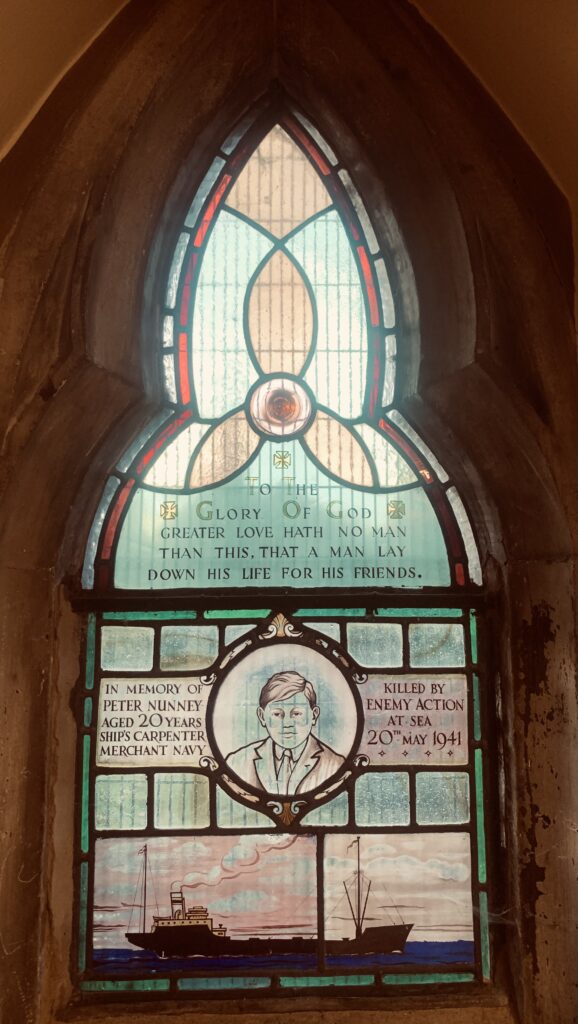
To the left of the west door a small stained glass window depicts Florence Nightingale (12 May 1820 – 13 August 1910). Florence Nightingale was born on 12 May 1820 into a wealthy and well-connected British family in Florence, Tuscany, Italy, and was named after the city of her birth. The family moved back to England in 1821, with Nightingale being brought up in the family’s homes at Embley, Hampshire, and Lea Hurst, Derbyshire was an English social reformer, statistician and the founder of modern nursing. Nightingale came to prominence while serving as a manager and trainer of nurses during the Crimean War, in which she organised care for wounded soldiers. She gave nursing a favourable reputation and became an icon of Victorian culture, especially in the persona of “The Lady with the Lamp” making rounds of wounded soldiers at night.
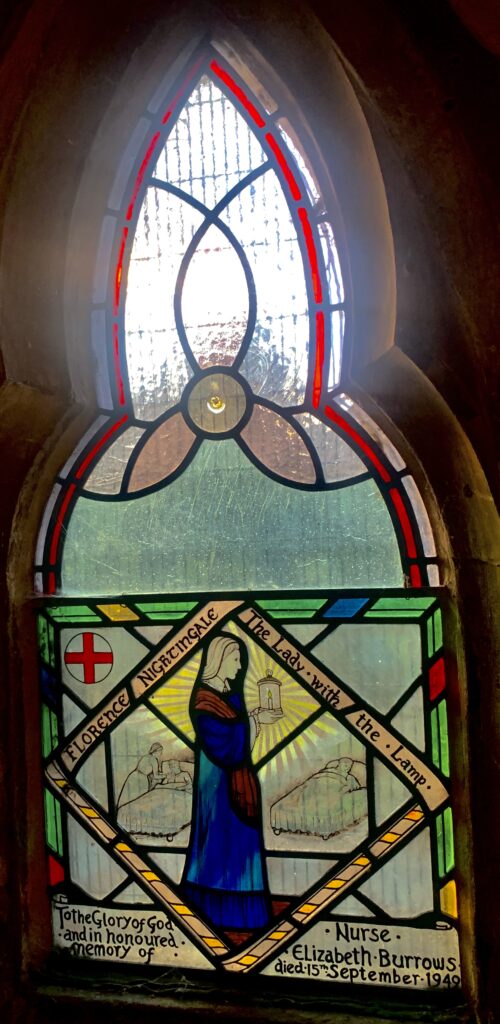
and is in memory of Nurse Elizabeth Burrows, a district nurse who died in 1949
The window (by Edward Frampton 1848-1929 who worked with Clayton & Bell) in the Services corridor pictures St. Hilda (or Hilda of Whitby) (c. 614–680) is a Christian Saint and the founding abbess of the monastery at Whitby, which was chosen as the venue for the Synod of Whitby. An important figure in the Christianisation of Anglo-Saxon England, she was abbess at several monasteries and recognised for the wisdom that drew kings to her for advice. In 657 Hilda became the founding abbess of Whitby Abbey, then known as Streoneshalh; she remained there until her death. Archaeological evidence shows that her monastery was in the Celtic style, with its members living in small houses, each for two or three people. The tradition in double monasteries, such as Hartlepool and Whitby, was that men and women lived separately but worshipped together in church. The exact location and size of the church associated with this monastery is unknown. Bede states that the original ideals of monasticism were maintained strictly in Hilda’s abbey. All property and goods were held in common; Christian virtues were exercised, especially peace and charity. Everyone had to study the Bible and do good works. The prestige of Whitby is reflected in the fact that King Oswiu of Northumberland chose Hilda’s monastery as the venue for the Synod of Whitby, the first synod of the Church in his kingdom. He invited churchmen from as far away as Wessex to attend the synod. Most of those present, including Hilda, accepted the King’s decision to adopt the method of calculating Easter currently used in Rome, establishing Roman practice as the norm in Northumbria. The monks from Lindisfarne, who would not accept this, withdrew to Iona, and later to Ireland
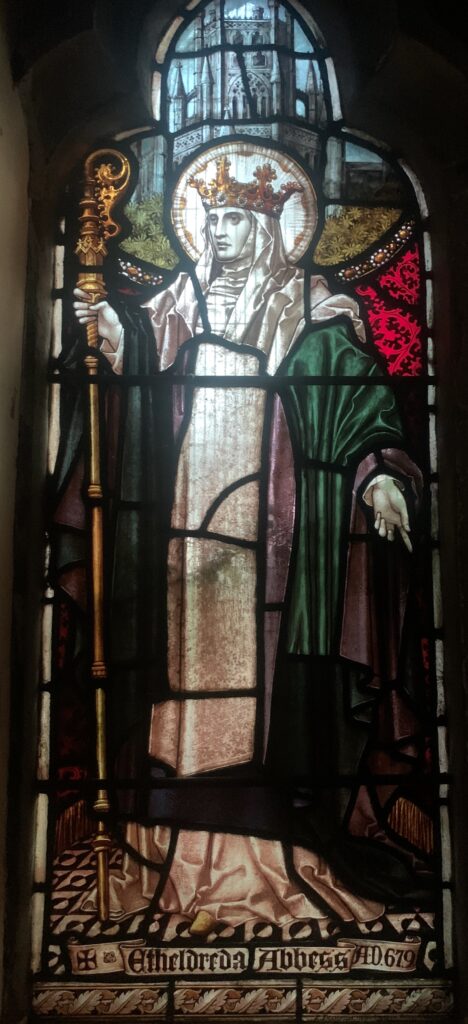
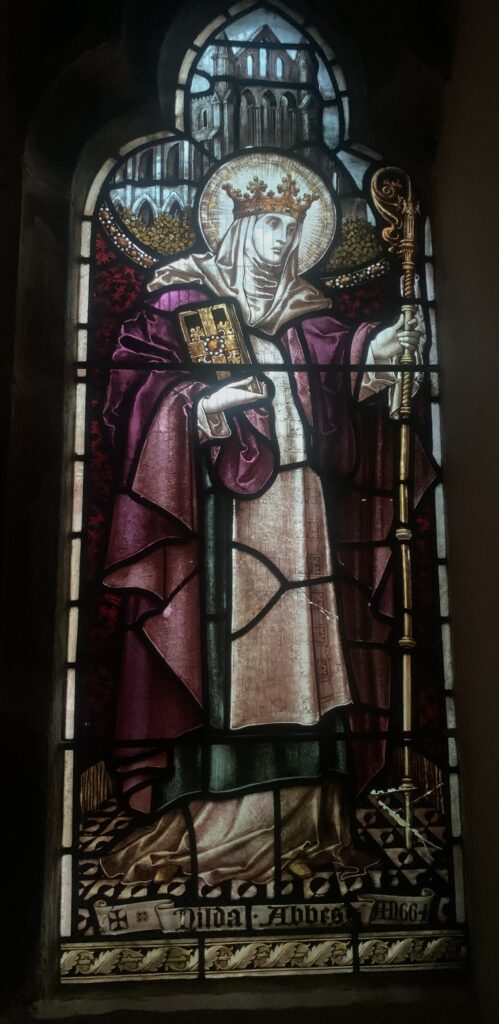
and St. Etheldra (c.636 – 23 June 679 AD) was an East Anglian princess, a Fenland and Northumbrian queen and Abbess of Ely. She is an Anglo-Saxon saint. Her father was King Anna of East Anglia, and siblings Wendreda and Seaxburh of Ely, both of whom eventually retired from secular life and founded abbeys.Etheldreda was the third and most celebrated of the saintly daughters of King Anna of East Anglia, by his wife, Saewara. Etheldreda was born at Exning in Suffolk, around AD 636, and was brought up in an atmosphere of piety. It was her ambition to be a nun like her sisters, but she was destined not to attain this goal until she had been twice married. In AD 652, she was given, against her will to, Tondbert, King of South Gyrwe, an East Anglian subkingdom in the Fens. As part of their marriage settlement, Tondbert gave his wife an estate then called Elge, and afterwards Ely. Tondbert, either respecting and sympathising with her monastic vocation or regarding her with indifference, allowed Etheldreda to live as a nun during the three years of their marriage.
In AD 660, for family reasons – probably to secure an alliance for the house of the Uffingas with the powerful Kingdom of Northumbria against the aggressive Mercians – she married Egfrith, the second son of Oswiu, King of Northumbria. At the time of his marriage, Egfrith was little more than a child. Etheldreda won his esteem and affection at once, and rapidly acquired a purifying and ennobling influence over him. He “held her as a thing enskied and sainted” Eventually in AD 673, Etheldreda built a large double monastery. She was made her abbess and gave the veil to her first nuns. Etheldreda ruled over her monastery for seven years, setting a great example of piety and abstinence and all other monastic virtues. Though such a great lady, and so delicately reared, she never wore any linen, but only rough woollen clothing. and is dedicated to the memory of the Hibberd sisters.
Stone Carvings.
The stone carvings which decorate the Church were the work of Mr. John Holden of Sheffield. Underneath and supporting the Chancel Arch are two figures representing Music and Praise, with Harp andCymbals. Above these on either side the arch are two heads, one of Queen Victoria with the sceptre of temporal power, and one of Bishop Selwyn of Lichfield with his crozier. There are also representations of Moses bearing the tables of the Law, and Melchizedek as priest and king, one hand bearing a scroll and the other uplifted in blessing. At the West end of the nave on the South side is Aaron as High Priest holding the Budding rod and on the North side a representation of Purity, with a lily. Either side the old vestry door are the Agnus Dei and the Chalice.
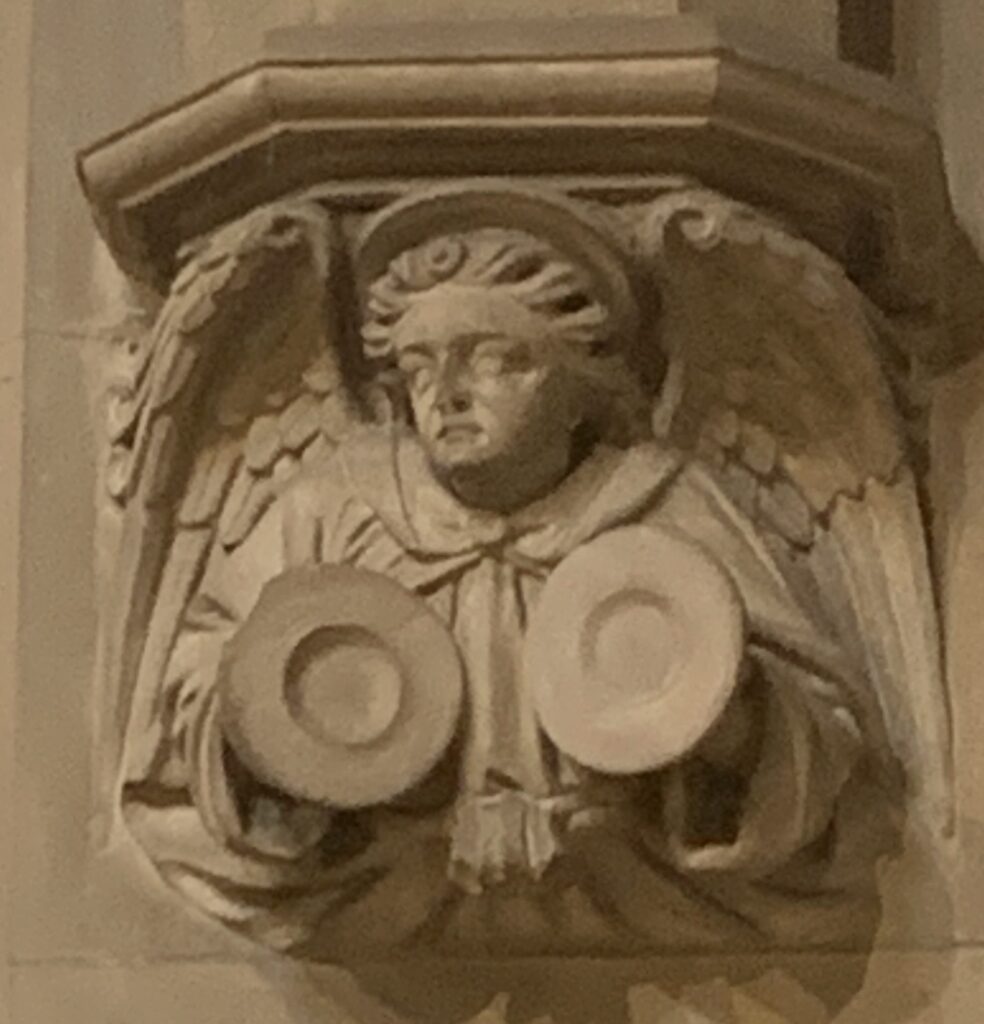
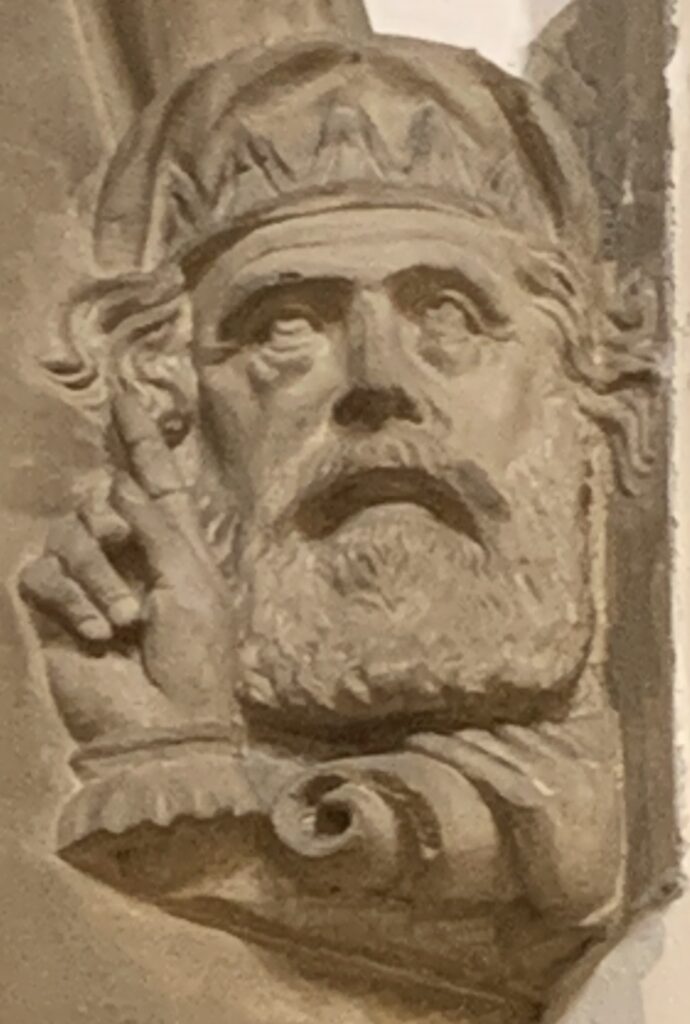
There are many more stone carvings on the outside of the Church and we assume these were carried out by the same person.
Church Plate.
The Church Plate has historical interest and receives mention in “The Church Plate of Derbyshire 1491 – 1850” by S. A. Jeavons (1961).
As follows
Silver paten.
A domed paten-cover on a narrow knob foot, inscribed “1620′,. No makers mark. Height I in., diameter 4 3/16 in.
Elizabethan. Silver chalice.
A wide, tapering beaker-shaped bowl, decorated with a central band of scroll- work, divided into three sections by inverted hour-glass curves, with pendant and upright trefoils at the intersections. The bowl rests upon a narrow neck decorated with a band of saltire ornament, above a spool-shaped stem with a large central knot, and high domed foot which seems to be a Later addition. No maker’s mark. Height 6 3/4 in., Weight 7 oz.
Silver flagon.
A cylindrical body with skirted base; attached to the scroll handle is a domed lid and thumb piece. Inscribed on the body .,To God & ye Church of whittington Peter webster of croydon Esqr. the munidcent Son & Grandson of a munificent Father & Grandfather both great Benefactors in this Parish gave this Flaggon AD 1753″. Maker’s mark- IS [possibly John Swift]. Height 8 3/4in., Weight 20oz. 5 dwt.
1753. Silver paten.
A plate like paten inscribed as above except for the substitution of the word ‘plate’ for ‘flagon’, and by the same maker. Diameter 8 3/8 in. weight 9 oz.
Another Silver Chalice, the one in general use,’was given by the Young Men’s Bible Class, in 1922, in memory of Rev. George Ford. The paten used with it is beautifully engraved with the words “This is my Body”.